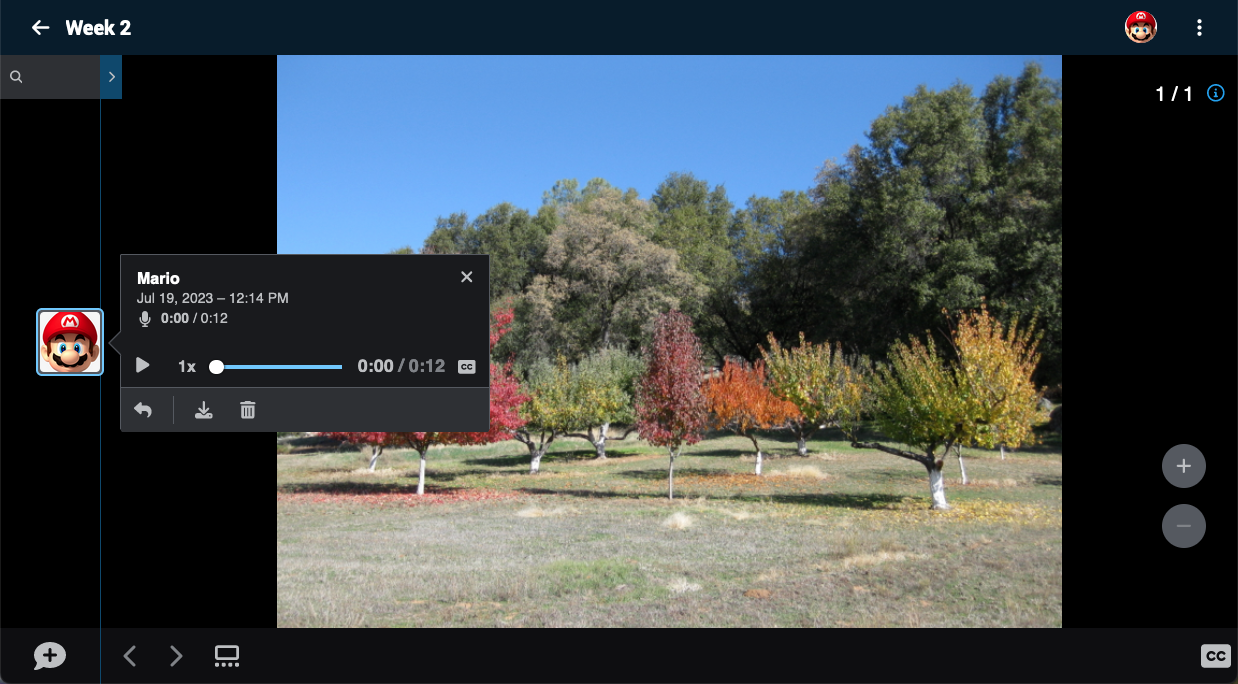
This fall, VoiceThreaders will be able to try out the brand new VoiceThread! The core experience will not change, so VoiceThread will still do everything you already do now, and it will have a fresh new look along with some powerful new features. It has also been built from the ground up with accessibility in mind.
Some highlights of that new experience include:
- A single experience accessible to everyone, including screen reader users
- Redesign of the VT Home Page to match the design of integrated assignments and the mobile app
- Fresh visual update to the media player to streamline, modernize, and enable support for new features
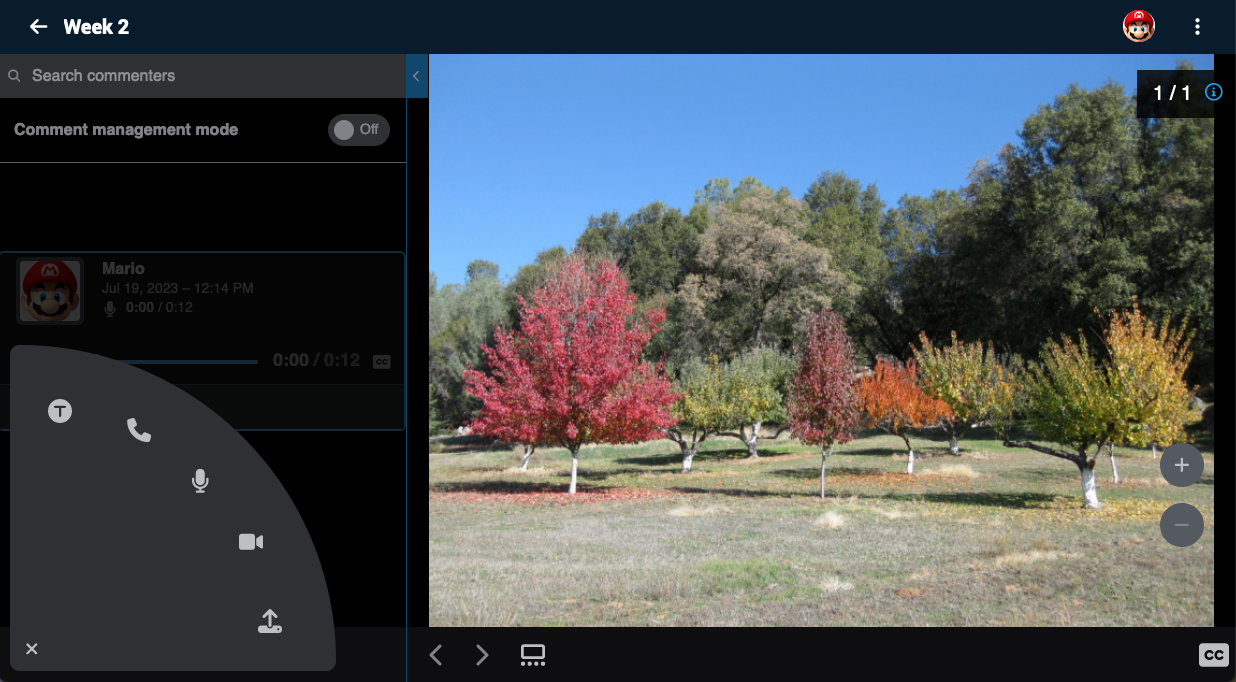
A few new features:
- Increased control of comment playback through the conversation channel
- Bulk actions on comments (delete, reveal moderated comments)
- True transcripts for captioned content
- Ability to pan while zoomed in and commenting
On top of being a massive usability and accessibility boost, this will pave the way for lots of new features in the coming months.
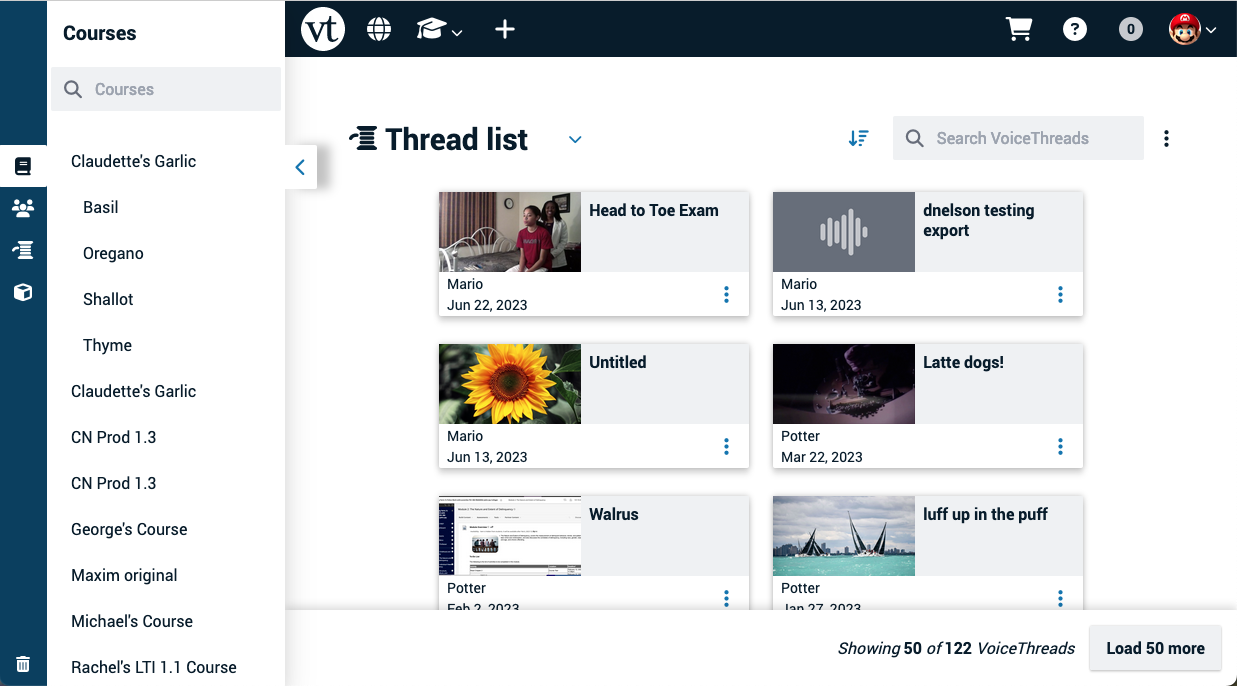
Speaking and listening are a big part of what Language Teachers do in face to face classrooms, but it can be difficult to replicate these activities in online courses. So many online courses silence student voices and that is a big problem for language teachers. VoiceThread can be the solution to this problem because it humanizes the online learning experience for students. Here are six ways VoiceThread can be used in language teaching:
-
Speaking Practice: VoiceThread allows students to practice their speaking skills by recording comments in the target language using audio or webcam comments. You can create prompts or questions related to the language topics being studied, and students can respond with their recorded answers. This provides an opportunity for students to practice pronunciation, fluency, and oral communication skills.
-
Listening Comprehension: You can record or upload audio and video slides and then ask students to listen and respond with their comments. Students can answer specific questions, summarize the content, or engage in discussions related to what they heard. This helps develop listening comprehension skills and encourages active, authentic engagement without the stress of live conversations.
-
Pronunciation and Intonation Practice: VoiceThread allows you to provide targeted feedback on students’ pronunciation and intonation. Students can record their spoken responses, and teachers can respond with voice or text comments, offering guidance, corrections, and suggestions for improvement. This personalized feedback can help students refine their pronunciation skills. You can respond directly to each student using the Threaded Reply feature.
-
Oral Presentations: VoiceThread can be used for student presentations in the target language. Students can create multimedia presentations by uploading slides, images, or videos and adding their voice narration. This allows them to practice their presentation skills, demonstrate their understanding of the topic, and receive feedback from both the teacher and peers.
-
Collaborative Projects: VoiceThread facilitates collaborative language learning projects. Students can work together on a shared VoiceThread, adding their voice or text comments to contribute to a discussion, debate, or group project. This promotes collaboration, critical thinking, and communication skills in the target language.
-
Cultural Exploration: VoiceThread can be used to explore and discuss cultural topics related to the target language. Teachers can upload images, videos, or articles that represent different aspects of the culture, and students can share their observations, ask questions, and engage in cross-cultural discussions through their comments.
These are just a few examples of how VoiceThread can be used by language teachers, but you can transform any of your current lesson and assessment ideas into VoiceThreads. The ability to use multimedia slides, interactive commenting, and the power to provide personalized, human feedback make VoiceThread a versatile tool for enhancing language learning and promoting communication for any languages that you teach.
2023 was a huge building year for us, and 2024 will be one where we can start adding great new stuff on top of the new scaffold. We’re excited to let you know what’s on the horizon!
2023 in Review
New VoiceThread
New VoiceThread is here, and we’re very excited! This is a major enhancement that will significantly increase human connectedness for both students and educators with its new accessibility features, a simplified design, and some significant new affordances.
For the next 5 months, we will be helping each institution make the transition to New VoiceThread on their own terms and timeline. You can flip the switch for your users any time between now and June 30, 2024.
To help you plan this transition, we’ve developed a number of supportive tools, from training materials and webinars to customized training sessions. To get you started, we have built a VoiceThread room to collaborate with you. The room starts off with a succinct 8 min overview, and because it’s a VoiceThread, we can always add more slides to help answer any questions you come up with. You can also read a full breakdown of the new features here.
To try it out now on your own personal account, just go to your display preferences page and select “New VoiceThread.” We’re big fans of self-paced change, so you can also go back to the same place to switch back to the legacy version of VoiceThread any time. Legacy VoiceThread will be supported until summer 2024.
New login options
Logging in isn’t exciting, but it’s enormously important! Smooth access is key to success, and more thought and work goes into that than you might think. In 2023 we introduced a redesign of our core login page to make it simpler for people to get where they need to go, as well as introduce a “Sign in with Apple” and “Sign in with Google” option for people wanting to access individual accounts without creating a separate password.
Assignments updates
Graded assignments are a powerful way to ask your students to complete specific tasks and receive a grade right in your LMS. This year we introduced the ability to grade students who haven’t begun to do any work (because sometimes you’ll want a policy of zero for this outcome, but sometimes not) and updated the watch assignment to help students see exactly which slides and comments they still need to watch in order to receive credit.
What's Next?
We have lots of great stuff on the horizon! And this year, we’re breaking down our plans a little differently. We have some things that we’re definitely working on this year and then some things that we really hope to finish by the end of the year but can’t yet be sure. Those less definite items are labeled “Bonus” below.
Full rollout of new VT
You already know that the new VoiceThread experience is available to everyone. You can transition over to that new version any time between now and June 30. If you haven’t opted into the new version by that date, we’ll be switching you over automatically.
Accessibility Updates
- Dark mode: For people who need or prefer a dark background.
- New in-line hinting workflow for new commenters.
- Bonus: Ability to edit captioning chunk timings and create new ones.
- Bonus: Overhaul of the “Manager” for license admins to have full screen reader and keyboard accessibility.
Content Management
- Delete, edit, and share VoiceThreads in bulk
- New button in comment window to copy a link to a specific comment
- New activity feed that includes more than just comments
- Drag-and-drop to share VoiceThreads with groups, courses, or ThreadBoxes
- Updated course interface and sections to better organize content within a course
- Course-level analytics
- Add tracks/sections/channels to ThreadBoxes to help organize larger conferences
- Bonus: Drag-and-drop to delete VoiceThreads
Assignments
- Customize when and how students can see the Student Gallery in Create Assignments
- Require students to comment on a classmate’s submission for a grade in a Create Assignment
- Bonus: Group assignments
- Bonus: Rubric grading
- Bonus: Support for “submitted” status with an LMS gradebook integration
Mobile
- Full mobile browser support, so a separate VoiceThread app is not required at all
- Ability to grade assignments on mobile devices
Login
- Ability to sign in with Microsoft
New licensing option
- “Student pay” mode for institutions that ask students to purchase their own access to VoiceThread
The arc of change in the teaching and learning universe may be long, but it bends towards a more accessible, equitable, inclusive, and human-centric world. We plan on shortening that arc just a little bit in 2023. But first, let’s take a look at what happened last year.
2022 in Review
Google and Apple Login
Anyone who has a Google account or Apple ID can use it to access VoiceThread now. On the main VoiceThread login page, you can simply click on the “Sign in with Google” or “Sign in with Apple” button. If you already have a VoiceThread account under that email address, we’ll just sign you into it.
Assignment Features
Formal assignments and other integrated activity types, available to any institution that uses VoiceThread in an integrated LMS, received a number of updates:
- Updated design and functionality for building VT Home, Course View, and Individual VT links
- Options to change a VoiceThread’s settings while building an Individual VT link
- New option to reconnect an existing assignment to a new link in your LMS
- Set a prerequisite assignment before students can work on the current one
- Added a close date that differs from due date
- Ability to disable the Assignment Builder in the Canvas “Modules” area (available upon request)
- Introduced an updated “slide gallery” view so that it is accessible for screen readers and keyboard users
Doodling Preferences
Whether you set your doodles to fade or not fade, that preference will be remembered until you opt to change it again.
Mobile Updates
We made a number of updates to the mobile app. Some of this is visible, but a substantial amount can only be “felt.” We did a major refactor to make the app more stable, improve error handling and cache/memory management, reduce load times, and make modals and messaging work better. Additional items added:
- Option to request account deletion on the “My Account” page
- Moved closed captions to the bottom of the screen
- Support for all new assignment features from the student experience
- Google and Apple login added
- Improvements to device rotation during recordings
- Option to switch identities from all editing pages
- Ability to message app users that an update is available
Accessibility Updates
- Added a slide description field so content creators can make their image slides more accessible
- Automated creation of descriptions and alt text from PDF and document slides
- Translated the new assignments interfaces
- Introduced an updated “slide gallery” view to assignments so that it is accessible for screen readers and keyboard users
- Moved closed captions to the bottom of the screen
Security
Strong security is a quest that never ends, but we made great strides in that area in 2022.
- Received our first SOC 2 report.
- Updated our backend QA environment to ensure that only anonymized data can be used in any test scenario.
- Increased group security when adding new members.
- Added authenticated callbacks for third-party closed caption integrations.
Backend Work
Behind-the-scenes work isn’t glamorous, but it is what makes all of our upcoming work possible!
- Automated key rollover to ensure strong security of integrations
- Refactored the closed caption handling
- Refactored our reporting infrastructure
- Performed several intensive library updates
- Built manifests and API endpoints to support upcoming features in 2023
Coming in 2023
The New VoiceThread
We’ve been working for a long time on unifying the VoiceThread experience across all platforms and for all types of users. This wasn’t possible back in the days when Adobe Flash was required and then HTML5, but we’re finally there now. This year, we’ll be releasing a completely overhauled version of VoiceThread that will be exactly the same for everyone and that was built with accessibility in mind from the ground up. Some highlights:
- A single interface accessible to everyone, including screen reader users.
- Redesign of the VT Home Page to match the design of integrated assignments and the mobile app.
- Redesign of the media player to streamline, modernize, and enable support for new features.
- A few new features:
- Ability to pan while zoomed in and commenting
- Bulk-reveal moderated comments
- Bulk-delete comments on a slide
- True transcripts provided for captioned content
There will be many more new features to come over time as a result of the new interface. When the new version is ready, we’ll alert everyone via email and give you the ability to test it on your own timeline. All administrators will have a window of time to decide when they would like their institution to move over to the new version so you can line up the transition with a convenient time for your users.
Zoom Oauth
Zoom is deprecating its JWT integration, which is what we have used in the past. We will be adding support Oauth integrations instead. We’ll be working with institutions to transition over before the June cutoff date.
Google Group Integration
If you use Google Classroom and already have a Google Suite integration for authentication, we will be able to create class groups in VoiceThread for each Google class and enroll students. This matches the roster integration for LTI integrations in learning management systems.
Microsoft Integration
We will be adding Microsoft integration for login and importing slides from OneDrive.
Assignments
For courses using formal assignments integrated in an LMS:
- New assignment type that requires students to comment on their classmates’ submissions from a previous assignment
- Ability to grade students who haven’t begun to work on an assignment
- Option to prevent students from seeing the Student Gallery in “Create” assignments until they have already submitted their own VoiceThread.
- Update the grader to better support instructor edits for captions, allow exporting, and remove the “Edit” button when it should not appear.
- Ability to view and even create assignments outside of an LTI integration in an LMS
Google Integration Update
Integration with Google Suite is the way many people access VoiceThread, especially in K-12. We’ll be adding two new features to our Google connection:
- Roster synchronization: If you use Google Classroom, we can automate the creation of VoiceThread courses to match those rosters.
- Sign in with Google: For independent users who want to sign in with Google instead of having a password specifically for VoiceThread.
Accessibility
The “New VoiceThread” will be our last step in unifying the standard and “universal” versions of VoiceThread. There will be a single, fully accessible experience for all users. This goal has been several years and iterations in the making, and we’re so proud to be reaching that goal this year. Of course we will never stop making improvements and collecting feedback, but this will be a major benchmark in the 16-year journey of bringing accessible multimedia learning environments to all students.
Additional features coming:
- Time chunk editing for closed captions
- Closed caption color/size/font customization
- Update ability to set personalized defaults for closed caption preferences
Mobile App
The mobile VoiceThread experience is another area where we’ll never be done growing, and 2023 will be no exception.
- Bulk VoiceThread editing actions
- Support for the updated slide gallery view
- Support for new media player features of the “New VoiceThread”
- Accessibility improvements to match the web experience
- Ability to play VoiceThreads in the mobile browser instead of forcing the app to launch
- Ability to grade assignments
Student Purchase Option
Some institutions and individual instructors want to use premium VoiceThread features with their students, but there is simply no funding available. A number of these institutions would like the option to require students to purchase their own “seats” in a license instead of funding everyone centrally. This should make VoiceThread more accessible to those institutions.
Thank you, as always, for your feedback, partnership, and innovation in bringing all these new features to life. We look forward to a brighter and more hopeful year!
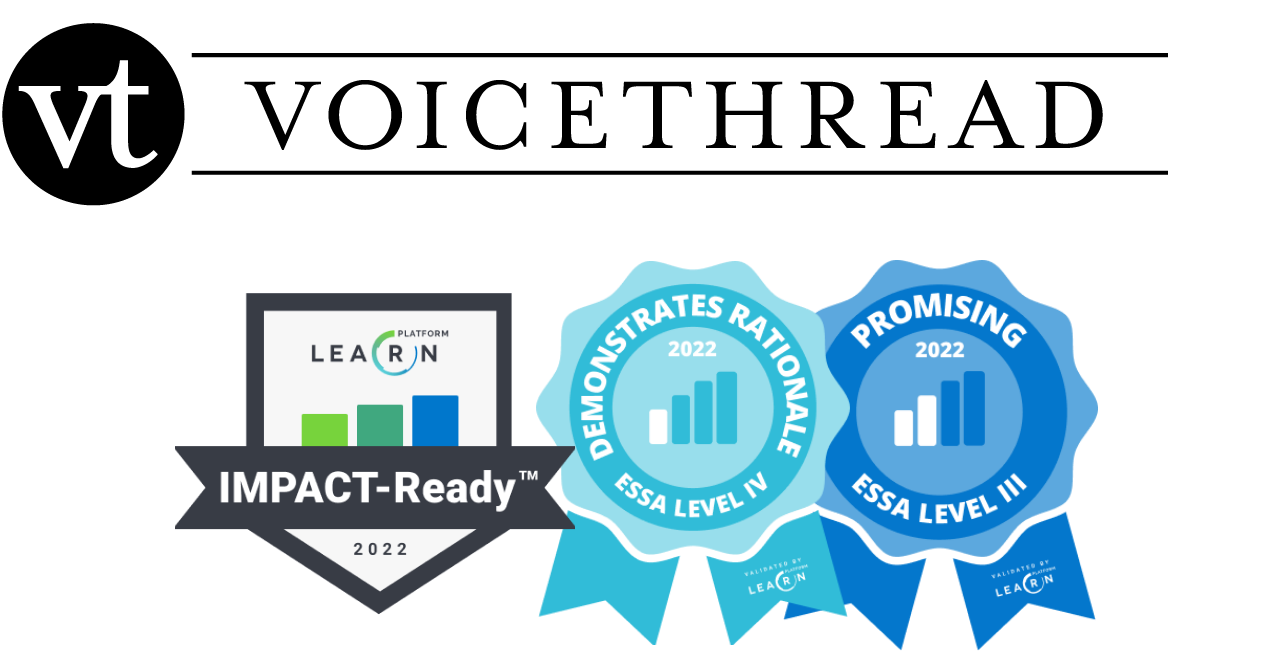
Veteran VoiceThread educators have been expanding their classrooms and providing students a place for them to practice their interpersonal and collaborative skills for over 15 years, and now we have formal validation of that winning strategy. After undertaking a review process with independent experts at the LearnPlatform, VoiceThread has been certified to meet Levels III & IV standards that are defined by the U.S. Department of Education Every Student Succeeds Act (ESSA). This is an important and impactful validation for us; however, ESSA validation is only part of the story.
VoiceThread’s co-founder and CEO, Steve Muth, explains “ESSA Level IV & Level III certification not only affirms that there is a research basis underlyingthe unique affordances that VoiceThreading offers, but it also validates the overall direction of our mission — humanizing the learning experience for both students and educators. We have known for a long time that high quality human-to-human interaction is not an elective component of a successful learning journey; it is a core requirement.”
What is ESSA? Why does it matter?
The Every Student Succeeds Act (ESSA) is a United States law passed in 2015 that empowers state and local educators to identify the needs of their own students and to select tools and strategies tailored to meet those needs. Tools with ESSA certification have undergone rigorous evaluation to prove that they are effective in improving student outcomes across the board.
What are the ESSA tiers of evidence?
ESSA’s tiers of evidence help learning institutions ensure the interventions deployed are backed by robust research. There are four tiers in total. The Level IV indicates that the intervention has a “well-defined logic model based on rigorous research,” and that further study is in the works to verify the approach’s efficacy. Level III attests that promising evidence of efficacy exists and is well documented in research findings. The Learn Platform reviewed our logic model and reviewed existing research to evaluate if there was sufficient evidence to support that logic model in the lived experiences of students.
What’s next
The VoiceThread executive and product teams will continue to work with the LearnPlatform to document, refine, and iterate on our logic model. The logic model is only the beginning of our efforts to understand and document specifically how VoiceThread has a positive impact on student learning. Partnering with learning researchers at K-20 institutions around the world, we plan to find out which affordances are most impactful, how, why, when, and for whom.
If you’re interested in the structure and details of research click here to get a copy of the Level IV report that was developed in partnership with LearnPlatform.
This is a guest post written by Nursing Educator and VoiceThreader, Joe Gomulak-Cavicchio EdD.
My first experience with VoiceThread came as an Educational Technology master’s student. I was learning about how to use it with K-12 students. However, I was thrilled to see it being used when I moved to higher education and jumped at the change to use VoiceThread in my own class. I knew when I was developing my completely asynchronous course, Integrating Technology in Nursing Education, it was going to play a prominent role.
Up to that point, I heard that graduate nursing students do not like online learning and they prefer face-to-face classes because it allows them the space to connect and have interactions with one another. Additionally, I knew from my own experience as a student, trying to juggle work, home, and school was quite the task and that I wasn’t always ready to engage with course content when a synchronous class occurred. I knew these graduate nursing students were working all different shifts and were not always going to be able to put forth their best effort. Therefore, I felt that if students were able to find ways to connect and humanize the other participants in the course that they could find online learning an enjoyable experience.
I knew I wanted to have weekly discussion boards and wanted to use VoiceThread. This would give us a chance to see and hear each other. However, the question I asked myself was, is this enough? Are we really connected? Then I did what all teachers do and thought about my experience as a student. As a face-to-face student we would spend the beginning parts of class sharing any news we had. Voila, I knew that this was going the start of how we were going to connect. I knew that if this was going to be a success I had to be a part of sharing good news.
However, sharing news was only a piece of the puzzle, I wanted something more, something to get more of my personality out there so students could really feel like they knew me. That is when I decided to share a joke with my class as a part of these weekly sharing discussion. I am not talking about the witty type of jokes that make you think, I am talking the ones that make you groan because they are so bad.
My wife and I met at the glue factory where we both worked.
We bonded immediately.
To my delight, this approach was a huge hit. Students would come on and before diving into the content they would comment on the joke, share one of their own, or just share good news. We all had a good laugh especially when a joke was delivered with utter seriousness. Students have also felt comfortable sharing if they are having a tough time because of the tone and connection that has been set.
The amazing thing is that this connection has extended beyond this class. I have had former students email me and share jokes when the come across a particularly groan-worthy one. Some former students have even shared that they have downloaded daily joke apps and share them with their coworkers during a pre-shift huddle.
About the Author:
Joe (@TechInNursingEd) is an assistant professor of clinical nursing, instructional designer, coordinator for online learning, and ADA access coordinator at the University of Rochester School of Nursing, where he has been for the past 8 years. He enjoys finding new and fun ways to engage with students online and in person
This is a guest post by educator and VoiceThreader, AJ Fitzgerald.
A common complaint about secondary and post-secondary education is that it’s simply not practical enough. Students commonly wonder aloud amongst their friends, “Why are we learning this?” Here on the internet, memes abound about how infrequently the average adult uses high school subjects like calculus and cellular biology in real life. The commenters often ask why they couldn’t have learned something useful instead, like taxes.

Though I’m proud to know calculus and certainly won’t be handing out tax advice anytime soon, I also recognize important feedback when I hear it. So this “practical information gap” is something we set out to address amongst our first year students at Temple University Rome. The (imperfect) solution we came up with was a 1-credit seminar that would cover such “practical” topics as adjusting to college (especially for international students), university/campus resources, study skills, goal-setting, time management, budgeting, education financing, and career prep.
Time constraints meant that we could only offer a brief introduction to each of these topics, but I knew that I wanted students to leave the course having practiced these important skills. For our career module, that meant actually drafting a resume and cover letter. But translating the third piece of the standard application process, the job interview, to the classroom environment proved a bigger logistical challenge than the rest. One hour wasn’t enough to conduct mock interviews during class time, and requiring students to meet me after class wasn’t ideal either. So in the first two semesters of the course we skipped the practical element of job interview prep – instead I shared some tips and advice during class and then moved on to their resume and cover letter drafts.
Though I don’t necessarily have fond memories of the initial lockdowns here in Italy, nor the frantic shift to online learning, that period was a great opportunity to re-assess much of what I’d been doing in my courses. I first started using VoiceThread for a creative writing class in Spring 2020, and found it a valuable tool to keep my students connected and engaged across oceans and time zones. After participating in a few training workshops as I continued to familiarize myself with the platform, I finally had the idea to try implementing a simulation exercise in my first year seminar. “VoiceThread Job Interview” was the result.
I keep telling myself that I should re-record the video slides for this activity, but I still rely on those original clips from Summer 2020. It had been months since a student physically stepped foot on our study abroad campus, and I still remember the eerie feeling of recording them in a cold, empty classroom. You can see plainly that my lockdown haircut was still in full effect, and I stumble over my words in a few places.
The recordings may not be perfect, but perhaps the authenticity of these imperfections helps put students at ease. After all, it’s meant to be a low-stakes activity for formative, not summative, feedback. I grade it on a complete/incomplete basis, and the point is for students to work out their thoughts and nerves in VoiceThread before moving on to high-stakes interviews in real professional settings. I ask them all the most common questions so that they can begin rehearsing their answers, and afterwards I provide individualized video feedback to each student. Comment moderation ensures that each student’s submission is shared only with me and not their fellow “candidates,” just as in a real interview. I initially worried that students would hesitate with the roleplaying aspect of this activity, but instead they often seem to dive in uninhibited. Some even dress for the part!
Compared to an in-person mock interview, VoiceThread’s biggest advantage is that it’s recorded. Students can re-listen to my feedback as often as they need, and they can also play back their own answers to get a feel for how they appear to the interviewer. Separating each interview question into separate videos slide allows for targeted feedback on each specific response. And as the human resources industry relies more and more on technology in the hiring process, I think VoiceThread uniquely prepares students for the type of online interview platforms they might soon encounter in real life.
We’re now back to teaching classes in-person here in Rome, but I still find myself returning to VoiceThread often when designing assignments and activities. Of course it’s great for student presentations, or make-up assignments when students miss class. Occasionally I also use it to return essay feedback quickly. But still my favorite application is the kind of practical simulation discussed here, and I look forward to designing similar activities in future semesters.
About the Author: AJ Fitzgerald is a writer/educator and Coordinator of the Academic Support Center at Temple University’s Overseas Campus in Rome, Italy. Holding degrees in both Physics and English, Fitzgerald’s creative/research interests lie at the intersection of STEM and the humanities: the relationships between science, science policy, literature and other creative media, as well as the socio-cultural impacts of advancements in science and technology. Follow him on Instagram (@ajftz4), Twitter (@ajfitz4), or LinkedIn.
The last couple of years have been a challenge, but they were also a time of unprecedented collaboration, innovation, and mutual support. We were inspired by how hard everyone worked to support students while not compromising their physical or psychological health. Everyone worked outside their comfort zone at some point by teaching fully online, observing social distancing, building hybrid courses, and handling student and faculty anxiety. We are honored to be part of that effort and are excited to share what we’ve been doing.
2021 in Review
New Assignments
On June 30 of this year, new VoiceThread assignments were rolled out to everybody. This was a major push to take all of your feedback and build cleaner, smarter, and more powerful assignments. In addition to a modernized and streamlined interface, here are just a few of the major feature updates:
Increased Control for Teachers
- Automatic access to student work
- Students cannot make changes to their work after submitting unless you allow it
- Dictate which settings apply to any VoiceThread that students create
- Decide whether students can view the assignment and their own contribution after submitting
- Send yourself a copy of a reminder email so you have a paper trail for student accountability
Editable Assignments
Make changes to your assignment after it has already been configured. This is great for fixing mistakes, tweaking based on student experience/feedback, and copying an assignment out to many different instructors so they can customize for their own sections.
Student Gallery
Allow students to see all classmates’ submissions for the current assignment in one place. No need to use a separate “Course View” link in your LMS.
Content Organization
Assignment content can only be accessed or controlled within the assignment directly, keeping students on track much more clearly.
Timed Release
Set an open and close date for the assignment so that students can’t access it outside of the desired availability window.
Customized Messaging
Set your own instructions and confirmation messaging for maximum clarity for your students.
Course Copying Policies
The new backend structure for assignments means we can be much more methodical in course copying policies. Now when you copy a course in your LMS, provided you are utilizing the LTI 1.3 integration, assignments are copied over without any student contributions. Only instructor content will be included.
Expanded Requirement Options
- Require students to add a set number of slides to their own VoiceThread in a Create Assignment or to yours in a Comment Assignment
- Require students to add comments to their own VoiceThreads in a Create Assignment
- Watch assignments now require students to watch video and audio slides in addition to comments
Clarity for Students
- Automated checklist of requirements to complete the assignment
- Clear due date and assignment status listed
- Reminders if students forget to submit work
- Watch assignment enumerates which slides/comments a student still needs to watch
Grading Flexibility
- Point value grading
- Complete/Incomplete grading
- Grade student work still in progress
- Find slides and comments contributed by each student directly from the grading panel
- Automatically see which students submitted an assignment late

Mobile App
Version 4.1 of the VoiceThread mobile app is available! This was an enormous back-end overhaul to the app, so even though it still looks very similar, this update improves performance and lays the groundwork for additional features. The updates in this version include:
- Streamlined authentication flow
- Updates to incorporate native components
- Allow audio playback when device is in silent mode
- ThreadBox support
- Browse page access
- Clearer loading animations
- Improved prompts for new users
- Updated sharing and permissions interfaces
- Student Gallery support in assignments
- Tool tips for switching cameras
- Fix: allow student assignment view to scroll
- Fix: prevent some large VoiceThreads from causing app crashes
Additionally, the VoiceThread app can be downloaded from the Amazon App Store now, in addition to the iOS App Store, Google Play, and Huawei.




Accessibility
We commit to baking accessibility into every step of VoiceThread development, from design to backend code. It isn’t an afterthought or something tacked onto an existing product. This approach is important to ensure that VoiceThread is accessible to everyone from the ground up. Read more about the overall accessibility trajectory planned for VoiceThread here.
Here are some new benchmarks we hit this year to further that goal:
New Purchasing Process
We know the purchasing process isn’t exciting, but it’s oh-so-important to how you adopt VoiceThread at the right pace for yourself or your institution. We’ve completely overhauled our system to be more intuitive, more flexible, and even more secure. The best purchasing system is one you don’t really notice, and we’re spending a lot of time making sure this works so smoothly that you don’t even know we’re there.
Security
Online security is a bit of an arms race crossed with interpretive dance. It’s always growing, evolving, and keeping everyone on their toes. We take security very seriously and have grown our security program significantly this year to back up our stance. Here’s some of what we have implemented:
- Expanded our team to include two full-time security officers
- Began implementation of NIST 800-171
- Began SOC 2 Type II review
- Updated encryption on uploaded media files
You already know that we offer workshops almost every week and certification cohorts throughout the year. These are great ways to connect with other VoiceThreaders and learn new ways VoiceThread can empower your students and enhance your courses. This year we’ve expanded in a few ways:
What's next?
With so many brand new platforms released in 2021, we are well primed to enhance, expand, and update like never before. We’re excited to share some of what’s in store next!
Assignments
The assignment offerings will continue to grow, and we have lots of great things planned for next year. These include:
- Add caption editing to the grader interface
- Support exports from assignments directly
- Group assignments
- Adaptive release
- Multi-step assignments
- Ability to display assignments directly on the VT Home Page
Mobile App
The mobile experience is also an ongoing project that we work on constantly. Some of the next things in line for mobile are:
- Ongoing enhancements to support OS updates, especially iOS 15 quirks
- Support grading via the app
- Support for using VoiceThread in the mobile browser
Security
As you saw from the 2021 review above, we’re right in the middle of several security certification and verification programs. We’ll be continuing with those large-scale projects with the aim of completing all of them by the end of 2022.
- SOC 2 Type II certification
- NIST 800-171 compliance
Infrastructure
This is yet another aspect of an online tool that is always ongoing, but this year we’ll be making a large migration to bigger and better infrastructure to help keep VoiceThread running smoothly and reliably as we grow.
Accessibility
You already know that accessibility is at the core of our development values at VoiceThread, and we have lots of benchmarks planned for the coming months. Those include:
- Moving closed captions for comments out of the comment bubble for greater visibility and conformance to expected practices
- Finalize a fully accessible version of the VoiceThread media player so that there is not a separate workflow between VT Standard and Universal
- Support of multiple closed caption files for the same piece of content
- Visual highlighting of transcript as media plays
Google Integration Update
Integration with Google Suite is the way many people access VoiceThread, especially in K-12. We’ll be adding two new features to our Google connection:
- Roster synchronization: If you use Google Classroom, we can automate the creation of VoiceThread courses to match those rosters.
- Sign in with Google: For independent users who want to sign in with Google instead of having a password specifically for VoiceThread.
Advanced Assessment
We’ve already begun beta testing an integrated quiz platform in VoiceThread. Our next step is to get those quizzes into the VoiceThread media player so that more instructors can start leveraging them.
Student Purchasing Option
Currently, all VoiceThread licenses are purchased by a school or institution, and students are covered by that larger purpose. We’ll never abandon that model, but a number of institutions have requested the option for students to purchase access to VoiceThread directly instead. We’ll be working with some partners to implement this with the goal of offering it to all interested institutions by the end of 2022.
The media player is the core of the VoiceThread experience. It’s where you listen, watch, speak, and write. We have some great updates and new features planned to improve that experience:
- Accessibility updates (detailed in the “Accessibility” section above)
- Ability to zoom and pan around on the slide while commenting and doodling
- Option to default to the “no-fade” doodle setting
- Reveal all moderated comments on a VoiceThread at once
- Bulk-delete comments and slides
Exports
Exporting allows you to save a VoiceThread offline for archival purposes. While the best VoiceThread experience is always going to be online, we know there are plenty of times you need to download your work. The updated export system will:
- Customize how the media player and comments look
- Decide which elements of the original VoiceThread to include in the export
- Add high-quality video option
Reporting and Analytics
Measuring usage and performance, especially in an education setting, are often key to success. We are growing our reporting to include not only usage, but also analysis and alerting capabilities at the license, course, thread, and user level.
Courses
Currently, all integrated assignment features are only available to institutions that purchase a full license and set up an LTI integration in their LMS. This year we’ll be introducing the ability to purchase an individual course without the need for an integration so that more instructors can take advantage of these features.
Thank you, as always, for your feedback, partnership, and innovation in bringing all these new features to life. We look forward to a brighter and more hopeful year!
This is a guest post by Educator and VoiceThreader, Bonnie Jean Nicholas.
I teach language and settlement to newcomers to Canada in a government-funded language program. Part of teaching settlement means guiding students as they develop the knowledge and skills that will enable them to find success in their new country. Presentation skills are important transferable skills, so students in my classes give mini presentations on different topics every week throughout our term. I use different modalities for these: sometimes face-to-face or in our synchronous online class; sometimes whole-class and sometimes in small groups, carousel style; and often using VoiceThread.
I like to think of VoiceThread as one more great tool in my teaching toolbox. I am reminded of the idiom: if the only tool you have is a hammer, then everything is a nail. As a teacher, I want to have a variety of ways for students to express themselves and to present, both so that they can develop those all important transferable skills and their digital skills but also so that they can have agency and voice in my classroom. In their feedback, many students prefer the asynchronous nature of VoiceThread, while others prefer to present synchronously in either our online class or our face-to-face class. And that’s where we see that word “voice” in VoiceThread: it truly does give students voice, both literally and figuratively.
VoiceThread also creates space for students to collaborate and develop their independence as well as their peer support network. As one student, N, says, “It was so easy after my classmate Z guided me how to follow the instructions. . . . I liked the asynchronous conversations on VoiceThread, and I always interacted with my classmates.” In our increasingly digital world, even students new to technology recognize that asynchronous interaction is a valuable way to connect and learn with their peers. Z themself says, “[VoiceThread] is easy to use, you can record your presentation, make comments, listen and pause whenever you want. So, it is a flexible tool to present.”
Other students commented that they found VoiceThread motivating because they could record and re-record their presentations until they were happy with the result, unlike a live presentation where they may have only one chance to speak and share. This reduces the stress level for learners, most of whom are new to presenting, and helps them develop confidence in their presentation skills. Students also value the comments and feedback from their peers, not just from their teacher. In their feedback, L says that they appreciated the “important questions and sweet comments” from their classmates. Using VoiceThread helps build community in our classroom.
In my classes, students give mini presentations on many different topics. Often, the presentations are only 2 - 3 minutes long; even this can be a daunting prospect in a new language for someone who has never given a presentation before. Generally, everyone presents on a variation of the same theme in any given week. I sometimes ask them to share idioms, phrasal verbs, collocations, or other useful forms of formulaic language. They sometimes share soft skills, government services, recommended books or films, or websites or courses to continue their learning after our class ends. VoiceThread allows their work to be preserved in an easily accessible format. As S says, “VoiceThread is a great way of learning.”
About the Author:
Bonnie Jean Nicholas, BA MEd, teaches in the Language Instruction for Newcomers to Canada (LINC) program at NorQuest College in Edmonton, Alberta, where she integrates digital technology with language teaching.
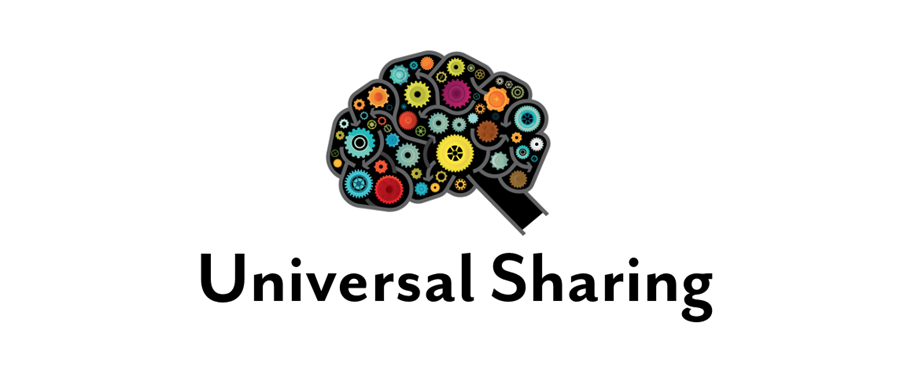
Sharing in VT Universal is here! VoiceThreaders who rely on VT Universal for screen reader access no longer need to swap to the standard version to share their VoiceThreads for collaboration. Share with individual contacts, with groups and courses, or with the whole world using an interface designed with accessibility in mind from the ground up.
What is VT Universal?
It’s a version of VoiceThread that is fully accessible to screen readers. It is the first thing a screen reader will detect on VoiceThread’s website, and it can be set as your default if you rely on a screen reader. Click here for full documentation.
Accessibility Trajectory
At the start of 2021, we released the new and improved version of VT Universal. This reboot created a strong foundation for us to continue adding more and more features until Universal becomes the standard experience. In the end there will no longer be two separate views of VoiceThread. The unified interface will be fully accessible. Adding the ability to share was a major step in this direction.
More features added to VT Universal in 2021
We are passionate about making high-quality interactions accessible to all learners, and we’re very excited that we’re so close to the finish line for this long journey.












